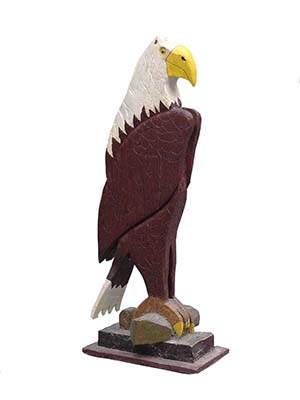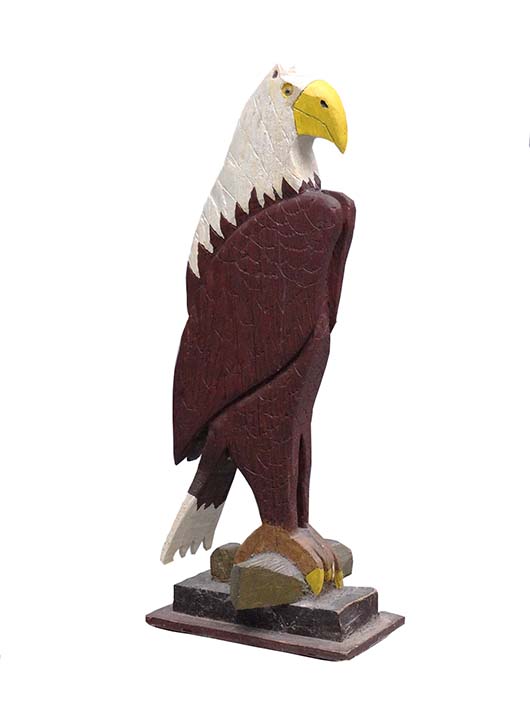
***
Q: My aunt left me a lamp. The base is a figurine of an 18th-century woman sitting at a piano gazing affectionately at a man with a lute. It sits on an oval brass base. Two curved arms extend from the back and they are decorated with a metal vine and tiny porcelain flowers. In the 1940s, my aunt was window shopping in Chicago with a friend, when she spotted and admired this lamp. Later, the bell boy in her hotel delivered it to her room. It was a gift! I’m interested in learning its maker and history. Value, too.
A: Your lamp is a typical example of porcelain made in the town of Dresden, Germany. Dresden porcelain is known for its naturalistic flowers and gilt trim, reticulation (cutout areas) and lace decorations. Figurines of 18th-century ladies and gentlemen, romantic couples, animal groups, cherubs and mythological subjects were popular. The most famous Dresden figurines are called “crinoline groups,” which show court-life scenes like people dancing and playing instruments. More than 200 porcelain-decorating studios operated in Dresden in the late 1800s and early 1900s. They decorated white porcelain made in Germany, Austria and France. Most porcelain blanks were not marked with the manufacturer’s mark. Your lamp probably was made in the 1930s and would sell for about $100. Replace the cord. Old cords are often cracked and are fire hazards.
***
Q: I have a brown clay type teapot that was my grandmother’s. It’s embossed with a girl at the well. I was told it was “Rebekah at the Well.” Can you tell me something about it? How old is it? Does it have any value?
A: “The Rebekah at the Well” teapot was first made by Edwin and William Bennett of Baltimore in 1851. The design was copied from a pot made by an English maker, Samuel Alcock & Company, in the 1840s. The mottled brown glaze is known as Rockingham. Bennett made Rebekah at the Well teapots until the factory closed in 1936. The relief design was so popular it was copied by other makers in the United States and England. It can be found on teapots, sugar bowls, pitchers and other items. Its value: $50 and up.
***
Q: I found a silk scarf in my grandmother’s belongings. The scarf has a small hand-sewn hem around the edges. In the center there is a circle with a statue of a horse and rider standing on a pediment that reads “1688” and surrounded by the words “The Glorious & Immortal Memory of 1688 & 1690.” Other symbols, including the harp of Ireland, are in the four corners of the scarf and the words “Aughrim,” “Derry,” “Enniskillen” and “Boyne” are along the sides. My grandmother’s parents were from Ireland. What does this represent?
A: Your scarf commemorates battles in the “Glorious Revolution,” when the Catholic king of England, James, was overthrown and replaced by the Protestant King William. The figure on the horse is William, who invaded England at the invitation of parliament in 1688. He and his wife, Mary, were crowned as monarchs of England in 1689. Then William invaded Scotland and Ireland, and became king of those countries, too. The places listed along the sides of your scarf were famous battles in Ireland. These battles still are commemorated by Orangemen in the Protestant parts of Ireland.
***
Q: What marking should be on the bottom to identify something as Fenton glass? I have seen a few different markings on items on eBay.
A: Fenton was founded in 1905 in Martins Ferry, Ohio. The company is known for its carnival glass made between 1907 and 1920. Most Fenton glass is marked “Fenton,” but some other marks also were used. Pieces marked with an “F” in an oval were made from molds bought from other glass companies. Pieces marked with the three letters “O,” “V” and “G” are part of Fenton’s Olde Virginia Glass line, made from 1960 to 1979. Fenton stopped making art glass in 2011. Copies of Fenton items currently are being made by an unrelated company, Fenton’s Collectibles, using original Fenton molds. The copies are marked with both the Fenton mark and Fenton’s Collectibles mark.
***
Tip: Advertising collectors should check every address, phone number, name and price information that is on a label, a sticker or the container. They will help with the research to determine the age of the product.
***
Terry Kovel and Kim Kovel answer questions sent to the column. By sending a letter with a question, you give full permission for use in the column or any other Kovel forum. Names, addresses or email addresses will not be published. We cannot guarantee the return of photographs, but if a stamped envelope is included, we will try. The amount of mail makes personal answers or appraisals impossible. Write to Kovels, (Name of this newspaper), King Features Syndicate, 300 W. 57th St., New York, NY 10019.
* * *
CURRENT PRICES
Current prices are recorded from antiques shows, flea markets, sales and auctions throughout the United States. Prices vary in different locations because of local economic conditions
Cruet, glass, feather pattern, pontil, McKee Brothers, c. 1896, 5 1/2 inches, $45.
Stand, Hepplewhite, cherry, drawer, square top, splayed legs, c. 1800, 28 x 18 x 18 inches, $125.
Toothpick holder, silver plated, circus bear on ball, side barrel, marked, Osborn & Co., c. 1885, 2 3/4 inches, $185.
Trivet, wedding, pierced date 1852, wrought iron, marked KW, KE, 13 inches, $240.
Fraktur, birth, watercolor, ink, on paper, two hearts, birds, children, Isaac Broft, 1806, 13 x 16 inches, $300.
Paperweight, pink flowers, green, white ground, domed, box, Paul Ysart, 20th century, 3 inches, $375.
Nautical quadrant, brass, glass lens, ebonized wood frame, case, Spenser, Barrett & Co., London, c. 1860, $415.
Atwater Kent radio, cathedral style, No. 82, 7 tubes, 1931, 19 1/2 inches, $450.
Pearlware figurine, Charity, woman with children, painted multicolor enamel, Staffordshire, c. 1800, 9 3/4 inches, $600.
Belleek figurine, Venus crouching on shell, bronzed, gilt bands on head and arms, black mark, c. 1885, 18 inches, $4,500.
***
The Kovels have navigated flea markets for decades. Learn from the best. “Kovels Flea Market Strategies: How to Shop, Buy and Bargain the 21st Century Way” by Terry Kovel and Kim Kovel tells you about the latest smartphone apps and websites to help you shop, share and ship, as well as what to wear, what to bring and, most importantly, how to negotiate your way to a bargain. Also, there are tips on spotting fakes, advice about paying for your purchases and shipping suggestions. Full-color booklet, 17 pages, 8 1/2 by 5 1/2 inches. Available only from Kovels for $7.95 plus $4.95 postage and handling. Order by phone at 800-303-1996; online at www.Kovels.com ; or mail to Kovels, Box 22900, Beachwood, OH 44122.
***
(c) 2014 by Cowles Syndicate Inc.

ADDITIONAL IMAGE OF NOTE



